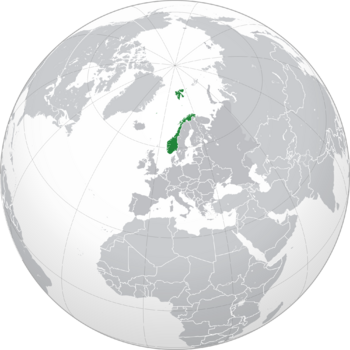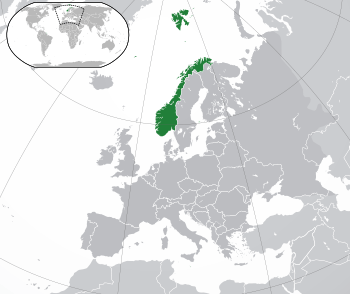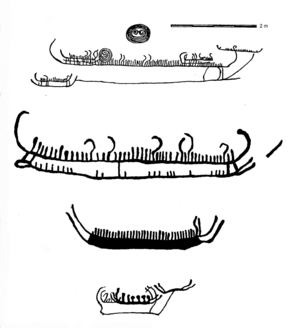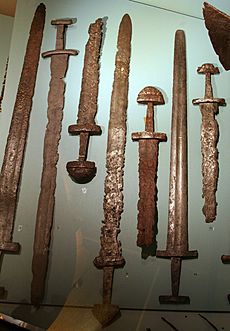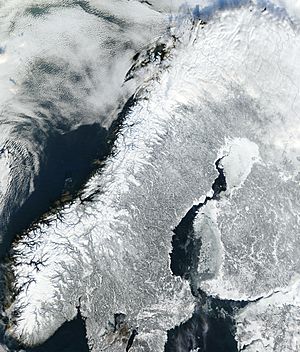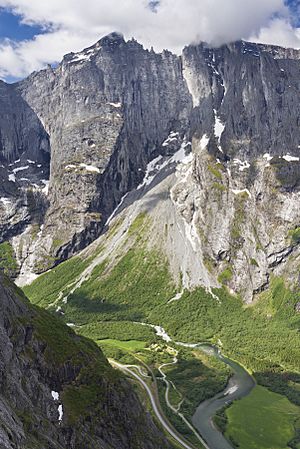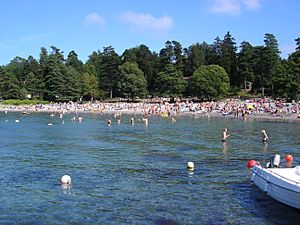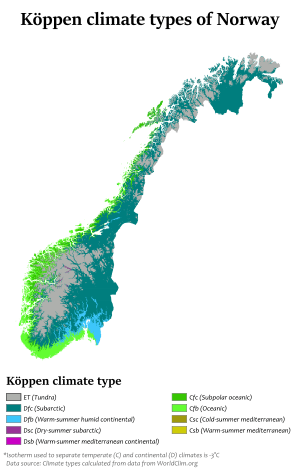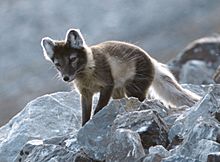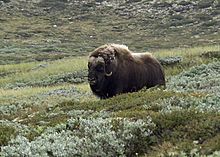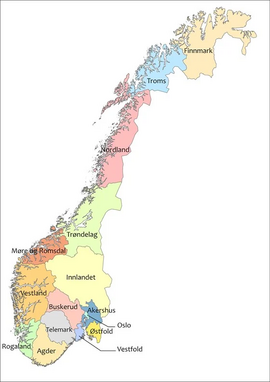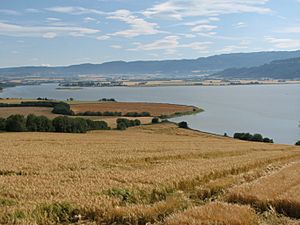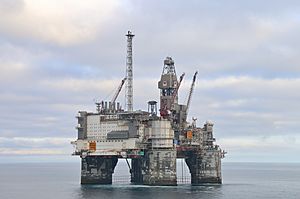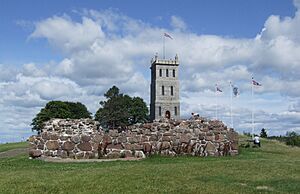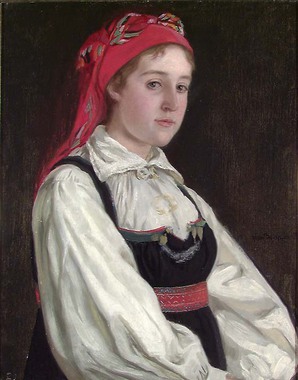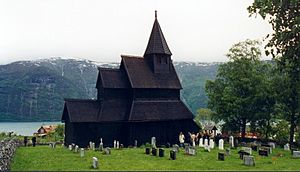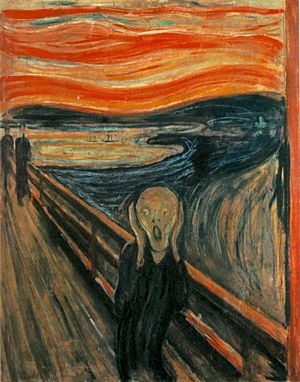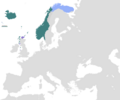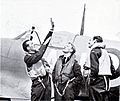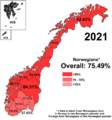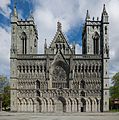Norway facts for kids
Quick facts for kids
Kingdom of Norway
Kongeriket Norge (Bokmål)
Kongeriket Noreg (Nynorsk) Other official names
|
|
|---|---|
|
Location of the Kingdom of Norway (green)
on the European continent (green and dark grey) |
|
| Capital and largest city
|
Oslo 59°56′N 10°41′E / 59.933°N 10.683°E |
| Official languages | |
| Recognised national languages | |
| Ethnic groups
(2021)
|
|
| Religion
(2021)
|
|
| Demonym(s) | Norwegian |
| Government | Unitary parliamentary constitutional monarchy |
|
• Monarch
|
Harald V |
| Jonas Gahr Støre | |
|
• President of the Storting
|
Masud Gharahkhani |
| Legislature | Storting |
| History | |
|
• State established prior to unification
|
872 |
|
• Old Kingdom of Norway (Peak extent)
|
1263 |
| 1397 | |
| 1524 | |
|
• Re-established state
|
25 February 1814 |
|
• Constitution
|
17 May 1814 |
| 4 November 1814 | |
|
• Dissolution of the union between Norway and Sweden
|
7 June 1905 |
| Area | |
|
• Total
|
385,207 km2 (148,729 sq mi) (61stb) |
|
• Water (%)
|
5.32 (2015) |
| Population | |
|
• 2024 estimate
|
|
|
• Density
|
14.4/km2 (37.3/sq mi) (227th) |
| GDP (PPP) | 2024 estimate |
|
• Total
|
|
|
• Per capita
|
|
| GDP (nominal) | 2024 estimate |
|
• Total
|
|
|
• Per capita
|
|
| Gini (2020) | ▼ 25.3 low |
| HDI (2022) | very high · 2nd |
| Currency | Norwegian krone (NOK) |
| Time zone | UTC+1 (CET) |
|
• Summer (DST)
|
UTC+2 (CEST) |
| Date format | dd.mm.yyyy |
| Driving side | right |
| Calling code | +47 |
| ISO 3166 code | NO |
| Internet TLD | .nod |
|
|
Norway is a country in the north of Europe. It is the western part of the Scandinavian peninsula. The mainland of Norway is surrounded by a coast on the west side and borders Russia, Finland, and Sweden to the east. The coast touches the Oslofjord, Skagerrak, and the North Sea.
The Kingdom of Norway has been independent since 1905. Its head of state is now King Harald V. The national day is May 17, which celebrates Norway's constitution of 1814. The parliament is called Stortinget and its members are elected by the people every 4 years.
About 5 million people live in Norway. The capital is the city of Oslo. It is also the largest city, with a population of over 942,000. Other major cities are Bergen with 251,000 people and Trondheim with 172,000; both of these have been the Norwegian capital in earlier years.
Norwegian is the national language. There are two official written versions of Norwegian called Bokmål and Nynorsk. Many Sami individuals are native speakers of one of the Sami languages. Nord-samisk is also an official language in a number of kommuner. ( Each kommune has a mayor. )
Contents
History
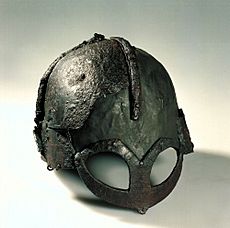
The unified kingdom of Norway was established in 872 as a merger of petty kingdoms and has existed continuously for 1,153 years. From 1537 to 1814, Norway was part of Denmark–Norway, and, from 1814 to 1905, it was in a personal union with Sweden. Norway was neutral during the First World War, and in the Second World War until April 1940 when it was invaded and occupied by Nazi Germany until the end of the war.
Harald V of the House of Glücksburg is the current King of Norway. Jonas Gahr Støre has been Prime Minister of Norway since 2021. As a unitary state with a constitutional monarchy, Norway divides state power between the parliament, the cabinet, and the supreme court, as determined by the 1814 constitution. Norway has both administrative and political subdivisions on two levels: counties and municipalities. The Sámi people have a certain amount of self-determination and influence over traditional territories through the Sámi Parliament and the Finnmark Act. Norway maintains close ties with the European Union and the United States. Norway is a founding member of the United Nations, NATO, the European Free Trade Association, the Council of Europe, the Antarctic Treaty, and the Nordic Council; a member of the European Economic Area, the WTO, and the OECD; and a part of the Schengen Area. The Norwegian dialects share mutual intelligibility with Danish and Swedish.
Geography
Norway's core territory comprises the western and northernmost portion of the Scandinavian Peninsula; the remote island of Jan Mayen and the archipelago of Svalbard are also part of the Kingdom of Norway. The Antarctic Peter I Island and the sub-Antarctic Bouvet Island are dependent territories and thus not considered part of the Kingdom. Norway also lays claim to a section of Antarctica known as Queen Maud Land. From the Middle Ages to 1814 Norway was part of the Danish kingdom. Norwegian possessions in the North Atlantic, Faroe Islands, Greenland, and Iceland, remained Danish when Norway was passed to Sweden at the Treaty of Kiel. Norway also comprised Bohuslän until 1658, Jämtland and Härjedalen until 1645, Shetland and Orkney until 1468, and the Hebrides and Isle of Man until the Treaty of Perth in 1266.
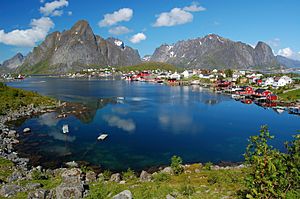
Norway comprises the western and northernmost part of Scandinavia in Northern Europe. Norway lies between latitudes 57° and 81° N, and longitudes 4° and 32° E. Norway is the northernmost of the Nordic countries and if Svalbard is included also the easternmost. Vardø at 31° 10' 07" east of Greenwich lies further east than St. Petersburg and Istanbul. Norway includes the northernmost point on the European mainland. The rugged coastline is broken by huge fjords and thousands of islands. The coastal baseline is 2,532 kilometres (1,573 mi). The coastline of the mainland including fjords stretches 28,953 kilometres (17,991 mi), when islands are included the coastline has been estimated to 100,915 kilometres (62,706 mi). Norway shares a 1,619-kilometre (1,006 mi) land border with Sweden, 727 kilometres (452 mi) with Finland, and 196 kilometres (122 mi) with Russia to the east. To the north, west and south, Norway is bordered by the Barents Sea, the Norwegian Sea, the North Sea, and Skagerrak. The Scandinavian Mountains form much of the border with Sweden.
At 385,207 square kilometres (148,729 sq mi) (including Svalbard and Jan Mayen) (and 323,808 square kilometres (125,023 sq mi) without), much of the country is dominated by mountainous or high terrain, with a great variety of natural features caused by prehistoric glaciers and varied topography. The most noticeable of these are the fjords: deep grooves cut into the land flooded by the sea following the end of the Ice Age. Sognefjorden is the world's second deepest fjord, and the world's longest at 204 kilometres (127 mi). Hornindalsvatnet is the deepest lake in all Europe. Norway has about 400,000 lakes. There are registred 239,057 islands. Permafrost can be found all year in the higher mountain areas and in the interior of Finnmark county. Numerous glaciers are found in Norway.
The land is mostly made of hard granite and gneiss rock, but slate, sandstone, and limestone are also common, and the lowest elevations contain marine deposits. Because of the Gulf Stream and prevailing westerlies, Norway experiences higher temperatures and more precipitation than expected at such northern latitudes, especially along the coast. The mainland experiences four distinct seasons, with colder winters and less precipitation inland. The northernmost part has a mostly maritime Subarctic climate, while Svalbard has an Arctic tundra climate.
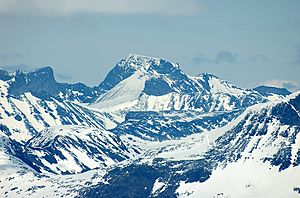
Because of the large latitudinal range of the country and the varied topography and climate, Norway has a larger number of different habitats than almost any other European country. There are approximately 60,000 species in Norway and adjacent waters (excluding bacteria and virus). The Norwegian Shelf large marine ecosystem is considered highly productive.
Climate
The southern and western parts of Norway, fully exposed to Atlantic storm fronts, experience more precipitation and have milder winters than the eastern and far northern parts. Areas to the east of the coastal mountains are in a rain shadow, and have lower rain and snow totals than the west. The lowlands around Oslo have the warmest and sunniest summers, but also cold weather and snow in wintertime.
Because of Norway's high latitude, there are large seasonal variations in daylight. From late May to late July, the sun never completely descends beneath the horizon in areas north of the Arctic Circle (hence Norway's description as the "Land of the Midnight sun"), and the rest of the country experiences up to 20 hours of daylight per day. Conversely, from late November to late January, the sun never rises above the horizon in the north, and daylight hours are very short in the rest of the country.
The coastal climate of Norway is exceptionally mild compared with areas on similar latitudes elsewhere in the world, with the Gulf Stream passing directly offshore the northern areas of the Atlantic coast, continuously warming the region in the winter. Temperature anomalies found in coastal locations are exceptional, with Røst and Værøy lacking a meteorological winter in spite of being north of the Arctic Circle. The Gulf Stream has this effect only on the northern parts of Norway, not in the south, despite what is commonly believed. The northern coast of Norway would thus be ice-covered if not for the Gulf Stream. As a side-effect, the Scandinavian Mountains prevent continental winds from reaching the coastline, causing very cool summers throughout Atlantic Norway. Oslo has more of a continental climate, similar to Sweden's. The mountain ranges have subarctic and tundra climates. There is also very high rainfall in areas exposed to the Atlantic, such as Bergen. Oslo, in comparison, is dry, being in a rain shadow. Skjåk in Oppland county is also in the rain shadow and is one of the driest places with 278 millimetres (10.9 inches) precipitation annually. Finnmarksvidda and the interior valleys of Troms and Nordland also receive less than 300 millimetres (12 inches) annually. Longyearbyen is the driest place in Norway with 190 millimetres (7.5 inches).
Parts of southeastern Norway including parts of Mjøsa have warm-summer humid continental climates (Köppen Dfb), while the more southern and western coasts are mostly of the oceanic climate (Cfb). Further inland in southeastern and northern Norway, the subarctic climate (Dfc) dominates; this is especially true for areas in the rain shadow of the Scandinavian Mountains. Some of the inner valleys of Oppland get so little precipitation annually, thanks to the rain shadow effect, that they meet the requirements for dry-summer subarctic climates (Dsc). In higher altitudes, close to the coasts of southern and western Norway, one can find the rare subpolar oceanic climate (Cfc). This climate is also common in Northern Norway, but there usually in lower altitudes, all the way down to sea level. A small part of the northernmost coast of Norway has the tundra/alpine/polar climate (ET). Large parts of Norway are covered by mountains and high altitude plateaus, many of which also exhibit the tundra/alpine/polar climate (ET).
Biodiversity
The total number of species include 16,000 species of insects (probably 4,000 more species yet to be described), 20,000 species of algae, 1,800 species of lichen, 1,050 species of mosses, 2,800 species of vascular plants, up to 7,000 species of fungi, 450 species of birds (250 species nesting in Norway), 90 species of mammals, 45 fresh-water species of fish, 150 salt-water species of fish, 1,000 species of fresh-water invertebrates, and 3,500 species of salt-water invertebrates. About 40,000 of these species have been described by science. The red list of 2010 encompasses 4,599 species.
Seventeen species are listed mainly because they are endangered on a global scale, such as the European beaver, even if the population in Norway is not seen as endangered. The number of threatened and near-threatened species equals to 3,682; it includes 418 fungi species, many of which are closely associated with the small remaining areas of old-growth forests, 36 bird species, and 16 species of mammals. In 2010, 2,398 species were listed as endangered or vulnerable; of these were 1250 listed as vulnerable (VU), 871 as endangered (EN), and 276 species as critically endangered (CR), among which were the grey wolf, the Arctic fox (healthy population on Svalbard) and the pool frog.
The largest predator in Norwegian waters is the sperm whale, and the largest fish is the basking shark. The largest predator on land is the polar bear, while the brown bear is the largest predator on the Norwegian mainland. The largest land animal on the mainland is the elk (American English: moose). The elk in Norway is known for its size and strength and is often called skogens konge, "king of the forest".
Environment
Attractive and dramatic scenery and landscape are found throughout Norway. The west coast of southern Norway and the coast of northern Norway present some of the most visually impressive coastal sceneries in the world. National Geographic has listed the Norwegian fjords as the world's top tourist attraction. The country is also home to the natural phenomena of the Midnight sun (during summer), as well as the Aurora borealis known also as the Northern lights.
The 2016 Environmental Performance Index from Yale University, Columbia University and the World Economic Forum put Norway in seventeenth place, immediately below Croatia and Switzerland. The index is based on environmental risks to human health, habitat loss, and changes in CO2 emissions. The index notes over-exploitation of fisheries, but not Norway's whaling or oil exports.
Politics and government


Norway is considered to be one of the most developed democracies and states of justice in the world. Since 2010, Norway has been classified as the world's most democratic country by the Democracy Index.
According to the Constitution of Norway, which was adopted on 17 May 1814 and was inspired by the United States Declaration of Independence and French Revolution, Norway is a unitary constitutional monarchy with a parliamentary system of government, wherein the King of Norway is the head of state and the prime minister is the head of government. Power is separated among the legislative, executive, and judicial branches of government, as defined by the Constitution, which serves as the country's supreme legal document.
The monarch officially retains executive power. But following the introduction of a parliamentary system of government, the duties of the monarch became strictly representative and ceremonial. The Monarch is commander-in-chief of the Norwegian Armed Forces, and serves as chief diplomatic official abroad and as a symbol of unity. Harald V of the House of Schleswig-Holstein-Sonderburg-Glücksburg ascended to the Norwegian throne in 1991, the first since the 14th century who has been born in the country. Haakon, Crown Prince of Norway, is the heir to the throne.
In practice, the Prime Minister exercises the executive powers. Constitutionally, legislative power is vested with both the government and the Parliament of Norway, but the latter is the supreme legislature and a unicameral body. Norway is fundamentally structured as a representative democracy. The Parliament can pass a law by simple majority of the 169 representatives, of which 150 are elected directly from 19 constituencies, and an additional 19 seats ("levelling seats") are allocated on a nationwide basis to make the representation in parliament correspond better with the popular vote for the political parties. A 4% election threshold is required for a party to gain levelling seats in Parliament.
The Parliament of Norway, called the Storting, ratifies national treaties developed by the executive branch. It can impeach members of the government if their acts are declared unconstitutional. If an indicted suspect is impeached, Parliament has the power to remove the person from office.
The position of prime minister is allocated to the member of Parliament who can obtain the confidence of a majority in Parliament, usually the current leader of the largest political party or, more effectively, through a coalition of parties; Norway has often been ruled by minority governments. The prime minister nominates the cabinet, traditionally drawn from members of the same political party or parties in the Storting, making up the government. The PM organises the executive government and exercises its power as vested by the Constitution.
Norway has a state church, the Lutheran Church of Norway, which has gradually been granted more internal autonomy in day-to-day affairs, but which still has a special constitutional status. Formerly, the PM had to have more than half the members of cabinet be members of the Church of Norway; this rule was removed in 2012. The issue of separation of church and state in Norway has been increasingly controversial. A part of this is the evolution of the public school subject Christianity, a required subject since 1739. Even the state's loss in a battle at the European Court of Human Rights at Strasbourg in 2007 did not settle the matter. As of 1 January 2017, the Church of Norway is a separate legal entity, and no longer a branch of the civil service. Through the Council of State, a privy council presided over by the monarch, the prime minister and the cabinet meet at the Royal Palace and formally consult the Monarch. All government bills need formal approval by the monarch before and after introduction to Parliament. The Council approves all of the monarch's actions as head of state.
Members of the Storting are directly elected from party-list proportional representation in nineteen plural-member constituencies in a national multi-party system. Historically, both the Norwegian Labour Party and Conservative Party have played leading political roles. In the early 21st century, the Labour Party has been in power since the 2005 election, in a Red–Green Coalition with the Socialist Left Party and the Centre Party. Since 2005, both the Conservative Party and the Progress Party have won numerous seats in the Parliament.
In national elections in September 2013, two political parties, Høyre and Fremskrittspartiet, were elected on promises of tax cuts, more spending on infrastructure and education, better services and stricter rules on immigration, formed a government. Erna Solberg became prime minister, the second female prime minister after Gro Harlem Brundtland and the first conservative prime minister since Jan P. Syse. Solberg said her win was "a historic election victory for the right-wing parties". Her centre-right government won re-election in the 2017 Norwegian parliamentary election. Norway's new centre-left cabinet under Prime Minister Jonas Gahr Støre, the leader the Labour Party, took office on 14 October 2021.
Administrative divisions
Norway, a unitary state, is divided into fifteen first-level administrative counties (fylke). The counties are administered through directly elected county councils who elect the County Mayor. Additionally, the King and government are represented in every county by a County Governor (Norwegian: statsforvalteren). The counties are then sub-divided into 357 second-level municipalities (Norwegian: kommuner), which in turn are administered by directly elected municipal council, headed by a mayor and a small executive cabinet. The capital of Oslo is considered both a county and a municipality. Norway has two integral overseas territories out of mainland: Jan Mayen and Svalbard, the only developed island in the archipelago of the same name, located far to the north of the Norwegian mainland.
There are 108 settlements that have town/city status in Norway (the Norwegian word by is used to represent these places and that word can be translated as either town or city in English). Cities/towns in Norway were historically designated by the King and used to have special rules and privileges under the law. This was changed in the late 20th century, so now towns/cities have no special rights and a municipality can designate an urban settlement as a city/town. Towns and cities in Norway do not have to be large. Some cities have over a million residents such as Oslo, while others are much smaller such as Honningsvåg with about 2,200 residents. Usually, there is only one town within a municipality, but there are some municipalities that have more than one town within it (such as Larvik Municipality which has the town of Larvik and the town of Stavern.
Largest populated areas
|
Largest cities or towns in Norway
According to Statistics Dec. 2018 |
||
|---|---|---|
| Rank | Name | Pop. |
| 1 | Oslo | 1,000,467 |
| 2 | Bergen | 255,464 |
| 3 | Stavanger/Sandnes | 222,697 |
| 4 | Trondheim | 183,378 |
| 5 | Drammen | 117,510 |
| 6 | Fredrikstad/Sarpsborg | 111,267 |
| 7 | Porsgrunn/Skien | 92,753 |
| 8 | Kristiansand | 61,536 |
| 9 | Ålesund | 52,163 |
| 10 | Tønsberg | 51,571 |
Economy
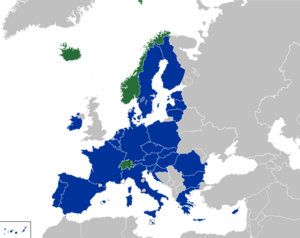
Norwegians enjoy the second-highest GDP per capita among European countries (after Luxembourg), and the sixth-highest GDP (PPP) per capita in the world. Norway ranks as the second-wealthiest country in monetary value, with the largest capital reserve per capita of any nation. The standard of living in Norway is among the highest in the world.
The Norwegian economy is an example of a mixed economy. Public healthcare in Norway is free, and parents have 46 weeks paid parental leave. The state income derived from natural resources includes a significant contribution from petroleum production. As of 2016[update], Norway has an unemployment rate of 4.8%, with 68% of the population aged 15–74 employed. The hourly productivity levels, as well as average hourly wages in Norway, are among the highest in the world.
The state has large ownership positions in key industrial sectors, such as the strategic petroleum sector (Equinor), hydroelectric energy production (Statkraft), aluminium production (Norsk Hydro), the largest Norwegian bank (DNB), and telecommunication provider (Telenor). Through these big companies, the government controls approximately 30% of the stock values at the Oslo Stock Exchange. When non-listed companies are included, the state has even higher share in ownership (mainly from direct oil licence ownership). Norway is a major shipping nation and has the world's sixth largest merchant fleet, with 1,412 Norwegian-owned merchant vessels.
By referendums in 1972 and 1994, Norwegians rejected proposals to join the European Union (EU). However, Norway, together with Iceland and Liechtenstein, participates in the European Union's single market through the European Economic Area (EEA) agreement. Norway has also acceded to the Schengen Agreement and several other intergovernmental agreements among the EU member states.
The country is richly endowed with natural resources including petroleum, hydropower, fish, forests, and minerals. Large reserves of petroleum and natural gas were discovered in the 1960s, which led to an economic boom. Norway has obtained one of the highest standards of living in the world in part by having a large amount of natural resources compared to the size of the population. In 2011, 28% of state revenues were generated from the petroleum industry.
Norway was the first country to ban deforestation.
Resources
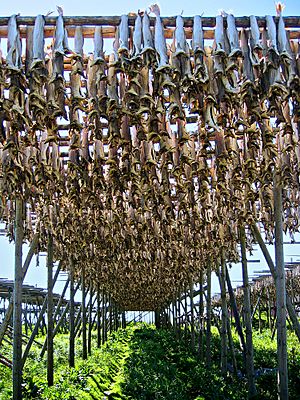
Oil industry
Export revenues from oil and gas have risen to over 40% of total exports and constitute almost 20% of the GDP. Norway is the fifth-largest oil exporter and third-largest gas exporter in the world, but it is not a member of OPEC. In 1995, the Norwegian government established the sovereign wealth fund ("Government Pension Fund – Global") to be funded with oil revenues.
The government controls its petroleum resources through a combination of state ownership in major operators in the oil fields (with approximately 62% ownership in Equinor in 2007) and the fully state-owned Petoro, which has a market value of about twice Equinor, and SDFI. Finally, the government controls licensing of exploration and production of fields. The fund invests in developed financial markets outside Norway. Spending from the fund is constrained by the budgetary rule (Handlingsregelen), which limits spending over time to no more than the real value yield of the fund, lowered in 2017 to 3% of the fund's total value.
Between 1966 and 2013, Norwegian companies drilled 5,085 oil wells, mostly in the North Sea. Oil fields not yet in the production phase include: Wisting Central—calculated size in 2013 at 65–156 million barrels of oil and 10 to 40 billion cubic feet (0.28 to 1.13 billion cubic metres), (utvinnbar) of gas. and the Castberg Oil Field (Castberg-feltet)—calculated size at 540 million barrels of oil, and 2 to 7 billion cubic feet (57 to 198 million cubic metres) (utvinnbar) of gas. Both oil fields are located in the Barents Sea.
Norway is also the world's second-largest exporter of fish (in value, after China). Fish from fish farms and catch constitutes the second largest (behind oil/natural gas) export product measured in value. Norway is the world's largest producer of salmon, followed by Chile.
Hydroelectric plants generate roughly 98–99% of Norway's electric power, more than any other country in the world.
Norway contains significant mineral resources, and in 2013, its mineral production was valued at US$1.5 billion (Norwegian Geological Survey data). The most valuable minerals are calcium carbonate (limestone), building stone, nepheline syenite, olivine, iron, titanium, and nickel.
In 2017, the Government Pension Fund controlled assets surpassed a value of US$1 trillion (equal to US$190,000 per capita), about 250% of Norway's 2017 GDP. It is the largest sovereign wealth fund in the world.
Other nations with economies based on natural resources, such as Russia, are trying to learn from Norway by establishing similar funds. The investment choices of the Norwegian fund are directed by ethical guidelines; for example, the fund is not allowed to invest in companies that produce parts for nuclear weapons. Norway's highly transparent investment scheme is lauded by the international community.
Transport
Due to the low population density, narrow shape and long coastlines of Norway, its public transport is less developed than in many European countries, especially outside the major cities. The country has long-standing water transport traditions, but the Norwegian Ministry of Transport and Communications has in recent years implemented rail, road, and air transport through numerous subsidiaries to develop the country's infrastructure. Under discussion is development of a new high-speed rail system between the nation's largest cities.
Norway's main railway network consists of 4,114 kilometres (2,556 mi) of standard gauge lines, of which 242 kilometres (150 mi) is double track and 64 kilometres (40 mi) high-speed rail (210 km/h) while 62% is electrified at 15 kV 16.7 Hz AC. The railways transported 56,827,000 passengers, 2,956 million passenger-kilometres, and 24,783,000 tonnes of cargo for 3,414 million tonne-kilometres. The entire network is owned by Bane NOR. Domestic passenger trains are operated by various companies, including Vy, SJ, Go-Ahead and Flytoget, while freight trains are operated by CargoNet and OnRail.
Investment in new infrastructure and maintenance is financed through the state budget, and subsidies are provided for passenger train operations. NSB operates long-haul trains, including night trains, regional services and four commuter train systems, around Oslo, Trondheim, Bergen and Stavanger.
Norway has approximately 92,946 kilometres (57,754 mi) of road network, of which 72,033 kilometres (44,759 mi) are paved and 664 kilometres (413 mi) are motorway. The four tiers of road routes are national, county, municipal and private, with national and primary county roads numbered en route. The most important national routes are part of the European route scheme. The two most prominent are the European route E6 going north–south through the entire country, and the E39, which follows the West Coast. National and county roads are managed by the Norwegian Public Roads Administration.
Norway has the world's largest registered stock of plug-in electric vehicles per capita. In March 2014, Norway became the first country where over 1 in every 100 passenger cars on the roads is a plug-in electric. The plug-in electric segment market share of new car sales is also the highest in the world. According to a report by Dagens Næringsliv in June 2016, the country would like to ban sales of gasoline and diesel powered vehicles as early as 2025.
Of the 98 airports in Norway, 52 are public, and 46 are operated by the state-owned Avinor. Seven airports have more than one million passengers annually. A total of 41,089,675 passengers passed through Norwegian airports in 2007, of whom 13,397,458 were international.
The central gateway to Norway by air is Oslo Airport, Gardermoen. Located about 35 kilometres (22 mi) northeast of Oslo, it is hub for the two major Norwegian airlines: Scandinavian Airlines and Norwegian Air Shuttle, and for regional aircraft from Western Norway. There are departures to most European countries and some intercontinental destinations. A direct high-speed train connects to Oslo Central Station every 10 minutes for a 20 min ride.
Research
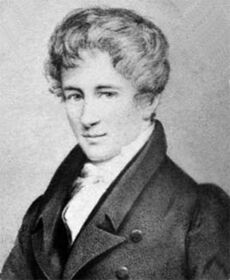
Internationally recognised Norwegian scientists include the mathematicians Niels Henrik Abel and Sophus Lie. Caspar Wessel was the first to describe vectors and complex numbers in the complex plane. Ernst S. Selmer's advanced research lead to the modernisation of crypto-algorithms. Thoralf Skolem made revolutionary contributions to mathematical logic. Øystein Ore and Ludwig Sylow made important contributions in group theory. Atle Selberg was one of the most significant mathematicians of the 20th century, for which he was awarded a Fields Medal, Wolf Prize and Abel Prize.
Other scientists include the physicists Ægidius Elling, Ivar Giaever, Carl Anton Bjerknes, Christopher Hansteen, William Zachariasen and Kristian Birkeland, the neuroscientists May-Britt Moser and Edvard Moser, and the chemists Lars Onsager, Odd Hassel, Peter Waage, Erik Rotheim, and Cato Maximilian Guldberg. Mineralogist Victor Goldschmidt is considered to be one of two founders of modern geochemistry. The meteorologists Vilhelm Bjerknes and Ragnar Fjørtoft played a central role in the history of numerical weather prediction. Web pioneer Håkon Wium Lie developed Cascading Style Sheets. Pål Spilling participated in the development of the Internet Protocol and brought the Internet to Europe. Computer scientists Ole-Johan Dahl and Kristen Nygaard are considered to be the fathers of the tremendously influential Simula and object-oriented programming, for which they were awarded a Turing Award.
In the 20th century, Norwegian academics have been pioneering in many social sciences, including criminology, sociology and peace and conflict studies. Prominent academics include Arne Næss, a philosopher and founder of deep ecology; Johan Galtung, the founder of peace studies; Nils Christie and Thomas Mathiesen, criminologists; Fredrik Barth, a social anthropologist; Vilhelm Aubert, Harriet Holter and Erik Grønseth, sociologists; Tove Stang Dahl, a pioneer of women's law; Stein Rokkan, a political scientist; and Ragnar Frisch, Trygve Haavelmo, and Finn E. Kydland, economists.
The Kingdom of Norway has produced thirteen Nobel laureates. Norway was ranked 21st in the Global Innovation Index in 2024.
Tourism
In 2008, Norway ranked 17th in the World Economic Forum's Travel and Tourism Competitiveness Report. Tourism in Norway contributed to 4.2% of the gross domestic product as reported in 2016. Every one in fifteen people throughout the country work in the tourism industry. Tourism is seasonal in Norway, with more than half of total tourists visiting between the months of May and August.
The main attractions of Norway are the varied landscapes that extend across the Arctic Circle. It is famous for its coastline and its mountains, ski resorts, lakes and woods. Popular tourist destinations in Norway include Oslo, Ålesund, Bergen, Stavanger, Trondheim, Kristiansand, Arendal, Tromsø, Fredrikstad, and Tønsberg. Much of the nature of Norway remains unspoiled, and thus attracts numerous hikers and skiers. The fjords, mountains and waterfalls in Western Norway and Northern Norway attract several hundred thousand foreign tourists each year. In the cities, cultural idiosyncrasies such as the Holmenkollen ski jump in Oslo and Saga Oseberg in Tønsberg attract many visitors, as do landmarks such as Bryggen in Bergen, Vigeland installation in Frogner Park in Oslo, Nidaros Cathedral in Trondheim, Fredrikstad Fortress (Gamlebyen) in Fredrikstad, and the ruin park of Tønsberg Fortress in Tønsberg.
Demographics

Norway's population was 5,384,576 people in the third quarter of 2020. Norwegians are an ethnic North Germanic people. The total fertility rate (TFR) in 2018 was estimated at 1.56 children born per woman, below the replacement rate of 2.1, it remains considerably below the high of 4.69 children born per woman in 1877. In 2018 the median age of the Norwegian population was 39.3 years.
The Sámi people are indigenous to the Far North and have traditionally inhabited central and northern parts of Norway and Sweden, as well as areas in northern Finland and in Russia on the Kola Peninsula. Another national minority are the Kven people, descendants of Finnish-speaking people who migrated to northern Norway from the 18th up to the 20th century. From the 19th century up to the 1970s, the Norwegian government tried to assimilate both the Sámi and the Kven, encouraging them to adopt the majority language, culture and religion. Because of this "Norwegianization process", many families of Sámi or Kven ancestry now identify as ethnic Norwegian.
The national minorities of Norway are Kvens, Jews, Forest Finns, and Romani people.
In 2017, the population of Norway ranked first on the World Happiness Report.
Languages
Norwegian in its two forms, Bokmål and Nynorsk, is the main national official language of all of Norway. Sámi, a group which includes three separate languages, is recognised as a minority language on the national level and is a co-official language alongside Norwegian in the Sámi administrative linguistic area (Forvaltningsområdet for samisk språk) in Northern Norway. Kven is a minority language and is a co-official language alongside Norwegian in one municipality, also in Northern Norway.
The primary foreign language taught in Norwegian schools is English, and the majority of the population, especially those born after World War II, is fairly fluent in English. German, French and Spanish are also commonly taught as second or, more often, third languages. Russian, Japanese, Italian, Latin, and rarely Chinese (Mandarin) are offered in some schools, mostly in the cities. Traditionally, English, German and French were considered the main foreign languages in Norway. These languages, for instance, were used on Norwegian passports until the 1990s, and university students have a general right to use these languages when submitting their theses.
90% of Norwegians are fluent in English.
Culture
The Norwegian farm culture continues to play a role in contemporary Norwegian culture. In the 19th century, it inspired a strong romantic nationalistic movement, which is still visible in the Norwegian language and media. Norwegian culture expanded with nationalist efforts to achieve an independent identity in the areas of literature, art and music. This continues today in the performing arts and as a result of government support for exhibitions, cultural projects and artwork.
Cinema
Norwegian cinema has received international recognition. The documentary film Kon-Tiki (1950) won an Academy Award. Another notable film is The Pinchcliffe Grand Prix, an animated feature film directed by Ivo Caprino. The film was released in 1975 and is the most widely seen Norwegian film of all time. Nils Gaup's Pathfinder (1987), the story of the Sámi, was nominated for an Oscar. Berit Nesheim's The Other Side of Sunday was nominated for an Oscar in 1997.
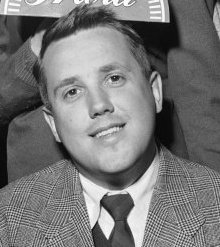
Since the 1990s, the film industry has expanded, producing up to 20 feature films each year. Particular successes were Kristin Lavransdatter, based on a novel by a Nobel Prize winner; The Telegraphist and Gurin with the Foxtail. Knut Erik Jensen was among the more successful new directors, together with Erik Skjoldbjærg, who is remembered for Insomnia. Elling and the 2012 adaption of Kon-Tiki was nominated for an Oscar for the best foreign language film. The TV-series Skam created by Julie Andem received a cult following and international recognition, with many countries making their own adaptations.
Norwegian directors such as Joachim Rønning, Anja Breien, Espen Sandberg, Liv Ullmann and Morten Tyldum have made internationally successful movies such as The Imitation Game, Passengers, Pirates of the Caribbean: Salazar's Revenge and Maleficent: Mistress of Evil, as well as the TV series Jack Ryan and Marco Polo. Composers include Thomas Bergersen, who composed for Avatar, The Dark Knight, Harry Potter and Narnia. Egil Monn-Iversen has been one of the most influential modern composers in Norway, having composed scores to over 100 Norwegian movies and TV series.
Norway has been used as filming location for Hollywood and other international productions, including Star Wars The Empire Strikes Back (1980). Among the thousands of movies filmed in Norway include Die Another Day, No Time to Die, The Golden Compass, Spies Like Us, Mission: Impossible – Fallout and Mission: Impossible – Dead Reckoning Part One, Black Widow, Tenet, Harry Potter and the Half-Blood Prince and Heroes of Telemark, as well as the TV series Lilyhammer and Vikings.
Music
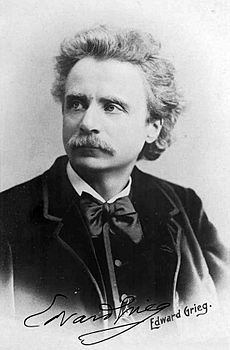
The classical music of the romantic composers Edvard Grieg, Rikard Nordraak and Johan Svendsen is internationally known, as is the modern music of Arne Nordheim. Norway's classical performers include Leif Ove Andsnes, a pianist; Truls Mørk, an outstanding cellist; and the Wagnerian soprano Kirsten Flagstad.
The Norwegian ballad tradition, known as the "ballad wave" (Norwegian: visebølgen), started as a cultural movement in the 1960s, greatly inspired by the Swedish ballad tradition and its modern representatives such as Olle Adolphson and Cornelis Vreeswijk. Some of its prominent representatives are Ole Paus, Lillebjørn Nilsen and Finn Kalvik.
The jazz scene is thriving. Jan Garbarek, Terje Rypdal, Mari Boine, Arild Andersen and Bugge Wesseltoft are internationally recognised while Paal Nilssen-Love, Supersilent, Jaga Jazzist and Wibutee are becoming world-class artists.
Norway has a strong folk music tradition which remains popular. Among the most prominent folk musicians are Hardanger fiddlers Andrea Een, Olav Jørgen Hegge and Annbjørg Lien, and the vocalists Agnes Buen Garnås, Kirsten Bråten Berg and Odd Nordstoga.
Norwegian black metal, a form of rock music in Norway, has been an influence in world music since the late 20th century. Since the 1990s, Norway's export of black metal has been developed by such bands as Emperor, Darkthrone, Gorgoroth, Mayhem, Burzum and Immortal. Bands such as Enslaved, Kvelertak, Dimmu Borgir and Satyricon have evolved the genre while still garnering worldwide fans.
Notable female solo artists from Norway include Susanne Sundfør, Sigrid, Astrid S, Adelén, Julie Bergan, Maria Mena, Tone Damli, Margaret Berger, Lene Marlin, Christel Alsos, Maria Arredondo, Marion Raven and Marit Larsen (both former members of the defunct pop-rock band M2M), Lene Nystrøm (vocalist of the Danish eurodance group Aqua) and Anni-Frid Lyngstad (vocalist of the Swedish pop group ABBA). Norwegian songwriters and producers for international artists include Stargate, Espen Lind, Lene Marlin and Ina Wroldsen.
Norway has been a constant competitor in the Eurovision Song Contest, participating 62 times. Since its first participation in 1960, Norway has won the competition three times: Bobbysocks's win in 1985, Secret Garden's win in 1995 and Alexander Rybak's win in 2009. Alexander Rybak's win in 2009 with his song Fairytale was a major win in Eurovision's history as it scored the biggest margin of victory ever. The song was an international hit, peaking at number one in several countries.
Norway enjoys many music festivals throughout the year, all over the country. Norway is the host of one of the world's biggest extreme sport festivals with music, Ekstremsportveko—a festival held annually in Voss. Oslo is the host of many festivals, such as Øyafestivalen and by:Larm. Oslo used to have a summer parade similar to the German Love Parade. In 1992, the city of Oslo wanted to adopt the French music festival Fête de la Musique. Fredrik Carl Størmer established the festival. From its first year, "Musikkens Dag" gathered thousands of people and artists in the streets of Oslo. "Musikkens Dag" is now renamed Musikkfest Oslo.
Literature
The history of Norwegian literature starts with the pagan Eddaic poems and skaldic verse of the ninth and tenth centuries, with poets such as Bragi Boddason and Eyvindr skáldaspillir. The arrival of Christianity around the year 1000 brought Norway into contact with European medieval learning, hagiography and history writing. Merged with native oral tradition and Icelandic influence, this influenced the literature written in the late 12th and early 13th centuries. Major works of that period include Historia Norwegiæ, Þiðrekssaga and Konungs skuggsjá.
Little Norwegian literature came out of the period of the Scandinavian Union and the subsequent Dano-Norwegian union (1387–1814), with some notable exceptions such as Petter Dass and Ludvig Holberg. During the union with Denmark, the government imposed using only written Danish, which decreased the writing of Norwegian literature.
Two major events precipitated a major resurgence in Norwegian literature: in 1811 a Norwegian university was established in Christiania, and in 1814 the Norwegians created their first Constitution. Authors were inspired and became recognised first in Scandinavia, and then worldwide; among them were Henrik Wergeland, Peter Christen Asbjørnsen, Jørgen Moe and Camilla Collett.
By the late 19th century, in the Golden Age of Norwegian literature, the so-called "Great Four" emerged: Henrik Ibsen, Bjørnstjerne Bjørnson, Alexander Kielland, and Jonas Lie. Bjørnson's "peasant novels", such as Ein glad gut (A Happy Boy) and Synnøve Solbakken, are typical of the Norwegian romantic nationalism of their day. Kielland's novels and short stories are mostly naturalistic. Although an important contributor to early romantic nationalism, (especially Peer Gynt), Henrik Ibsen is better known for his pioneering realistic dramas such as The Wild Duck and A Doll's House.
In the 20th century, three Norwegian novelists were awarded the Nobel Prize in Literature: Bjørnstjerne Bjørnson in 1903, Knut Hamsun for the book Markens grøde ("Growth of the Soil") in 1920, and Sigrid Undset (known for Kristin Lavransdatter) in 1928.
Architecture
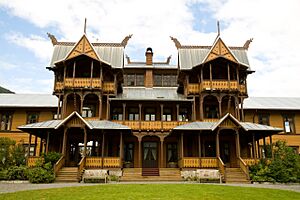
With expansive forests, Norway has long had a tradition of building in wood. Many of today's most interesting new buildings are made of wood, reflecting the strong appeal that this material continues to hold for Norwegian designers and builders.
With Norway's conversion to Christianity, churches were built. Stonework architecture was introduced from Europe for the most important structures, beginning with the construction of Nidaros Cathedral in Trondheim. In the early Middle Ages, wooden stave churches were constructed throughout Norway. Some of them have survived; they represent Norway's most unusual contribution to architectural history. Urnes Stave Church in inner Sognefjord is on UNESCO's World Heritage List. Another notable example of wooden architecture is the buildings at Bryggen Wharf in Bergen, also on the list for World Cultural Heritage sites, consisting of a row of tall, narrow wooden structures along the quayside.
In the 17th century, under the Danish monarchy, cities and villages such as Kongsberg and Røros were established. The city Kongsberg had a church built in the Baroque style. Traditional wooden buildings that were constructed in Røros have survived.
After Norway's union with Denmark was dissolved in 1814, Oslo became the capital. The architect Christian H. Grosch designed the earliest parts of the University of Oslo, the Oslo Stock Exchange, and many other buildings and churches constructed in that early national period.
At the beginning of the 20th century, the city of Ålesund was rebuilt in the Art Nouveau style, influenced by styles of France. The 1930s, when functionalism dominated, became a strong period for Norwegian architecture. It is only since the late 20th century that Norwegian architects have achieved international renown. One of the most striking modern buildings in Norway is the Sámi Parliament in Kárášjohka, designed by Stein Halvorson and Christian Sundby. Its debating chamber, in timber, is an abstract version of a lavvo, the traditional tent used by the nomadic Sámi people.
Art
For an extended period, the Norwegian art scene was dominated by artwork from Germany and Holland as well as by the influence of Copenhagen. It was in the 19th century that a truly Norwegian era began, first with portraits, later with impressive landscapes. Johan Christian Dahl, originally from the Dresden school, eventually returned to paint the landscapes of western Norway, defining Norwegian painting for the first time."
Norway's newly found independence from Denmark encouraged painters to develop their Norwegian identity, especially with landscape painting by artists such as Kitty Kielland, a female painter who studied under Hans Gude, and Harriet Backer, another pioneer among female artists, influenced by impressionism. Frits Thaulow, an impressionist, was influenced by the art scene in Paris as was Christian Krohg, a realist painter.
Of particular note is Edvard Munch, a symbolist/expressionist painter who became world-famous for The Scream which is said to represent the anxiety of modern man. Other notable works from Munch includes The Sick Child, Madonna and Puberty.
Other artists of note include Harald Sohlberg, a neo-romantic painter remembered for his paintings of Røros, and Odd Nerdrum, a figurative painter who maintains that his work is not art, but kitsch.
Cuisine
Norway's culinary traditions show the influence of long seafaring and farming traditions, with salmon (fresh and cured), herring (pickled or marinated), trout, codfish, and other seafood, balanced by cheeses (such as brunost, Jarlsberg cheese, and gamalost), dairy products, and breads (predominantly dark/darker).
Lefse is a Norwegian potato flatbread, usually topped with large amounts of butter and sugar, most commonly eaten around Christmas. Traditional Norwegian dishes include lutefisk, smalahove, pinnekjøtt, raspeball, and fårikål. A Norwegian speciality is rakefisk, which is fermented trout, consumed with thin flatbread and sour cream. The most popular pastry is vaffel.
Sports
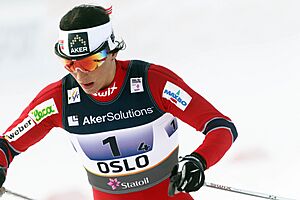
Sports are a central part of Norwegian culture, and popular sports include cross-country skiing, ski jumping, mountaineering, hiking, association football, handball, biathlon, speed skating, and, to a lesser degree, ice hockey.
Norway is known internationally for its role in the development of modern winter sports, particularly skiing. From the 19th century Norway also became a premier mountaineering destination, with books such as William Cecil Slingsby's Norway, the Northern Playground contributing to the country's popularity among early mountain climbers.
Association football is the most popular sport in Norway in terms of active membership. In 2014–2015 polling, football ranked far behind biathlon and cross-country skiing in terms of popularity as spectator sports. Ice hockey is the biggest indoor sport. The women's handball national team has won several titles, including two Summer Olympics championships (2008, 2012), three World Championships (1999, 2011, 2015), and six European Championship (1998, 2004, 2006, 2008, 2010, 2014).
In association football, the women's national team has won the FIFA Women's World Cup in 1995 and the Olympic Football Tournament in 2000. The women's team also has two UEFA European Women's Championship titles (1987, 1993). The men's national football team has participated three times in the FIFA World Cup (1938, 1994, and 1998), and once in the European Championship (2000). The highest FIFA ranking Norway has achieved is second, a position it has held twice, in 1993 and in 1995.
Norwegian players in the National Football League include Halvor Hagen, Bill Irgens, Leif Olve Dolonen Larsen, Mike Mock, and Jan Stenerud.
Bandy is a traditional sport in Norway and the country is one of the four founders of Federation of International Bandy. In terms of licensed athletes, it is the second biggest winter sport in the world. As of January 2018, the men's national team has captured one silver and one bronze, while the women's national team has managed five bronzes at the World Championships.
Norway first participated at the Olympic Games in 1900, and has sent athletes to compete in every Games since then, except for the sparsely attended 1904 Games and the 1980 Summer Olympics in Moscow when they participated in the American-led boycott. Norway leads the overall medal tables at the Winter Olympic Games by a considerable margin. Norway has hosted the Games on two occasions:
- 1952 Winter Olympics in Oslo
- 1994 Winter Olympics in Lillehammer
It also hosted the 2016 Winter Youth Olympics in Lillehammer, making Norway the first country to host both Winter regular and Youth Olympics.
Norway featured a women's national team in beach volleyball that competed at the 2018–2020 CEV Beach Volleyball Continental Cup.
Chess has gained huge popularity in Norway. Magnus Carlsen, a Norwegian, was the world chess champion between 2013 and 2023.
Related pages
Images for kids
-
Opening of Ohthere's Old English account, translated: "Ohthere told his lord Ælfrede king that he lived northmost of all Norwegians…"
-
Bryggen in Bergen, once the centre of trade in Norway under the Hanseatic League trade network, now preserved as a World Heritage Site
-
A Sámi family in Norway, c. 1900
-
Scenes from the Norwegian Campaign in 1940
-
Called elg in Norwegian, the moose is the main national animal.
-
Minneapolis–Saint Paul has the largest concentration of ethnic Norwegians outside Norway, at 470,000.
-
Nidaros Cathedral in Trondheim
-
The main building of the Norwegian University of Science and Technology in Trondheim
-
Hardingfele, the "Hardanger fiddle", a Norwegian instrument
See also
 In Spanish: Noruega para niños
In Spanish: Noruega para niños




